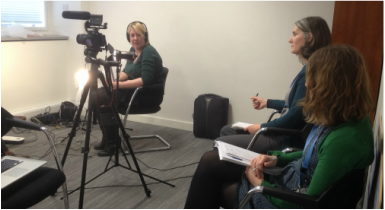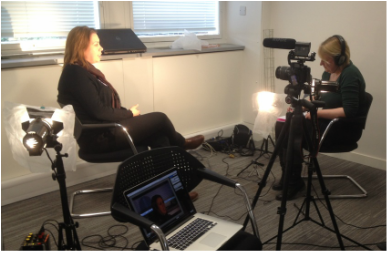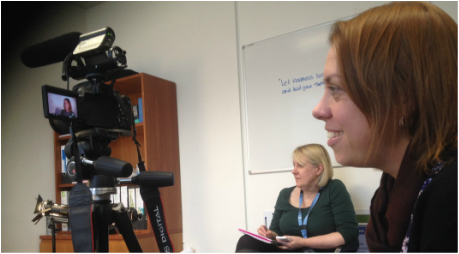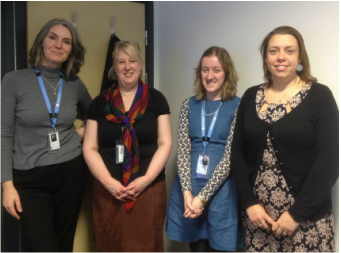 Students directing an interview shoot
Students directing an interview shoot I recently delivered a 3 day training course through Film Oxford at a charity in Northampton. My role was to teach a team of four in the e-learning department how to record and edit better interviews at their offices. The team already had some experience but wanted to improve the quality of their output to make their films more enjoyable to watch. This included making more out of their existing equipment and considering new kit.
 Students in the roles of interviewer and subject
Students in the roles of interviewer and subject On day one we covered production. This included lighting the subject and scene before recording the footage. We experimented with different light sources, positions, angles, settings and diffusion to see what effect this had on the image.
As the team were using a DSLR camera we acquired the video and audio of the subject separately using a technique called 'dual system audio'. We reviewed different types of microphone and the listened to the effect of varying their handling and placement.
We also tested the impact of using different backdrops - window, wall, backdrop and greenscreen. With each new setup we recorded a fresh interview with another trainee as the subject. We rotated the roles so every delegate got hands on experience of each crew discipline while what practicing what they had learned as a team.
By the end of the day the team could already appreciate the difference that these techniques had made to the look and sound of their footage.
As the team were using a DSLR camera we acquired the video and audio of the subject separately using a technique called 'dual system audio'. We reviewed different types of microphone and the listened to the effect of varying their handling and placement.
We also tested the impact of using different backdrops - window, wall, backdrop and greenscreen. With each new setup we recorded a fresh interview with another trainee as the subject. We rotated the roles so every delegate got hands on experience of each crew discipline while what practicing what they had learned as a team.
By the end of the day the team could already appreciate the difference that these techniques had made to the look and sound of their footage.
 Student rotated their production roles
Student rotated their production roles On the second day we started post-production.
We imported footage from the camera and audio recorder and assembled a rough edit
using Adobe non-linear editing software Premiere Pro CC. This included methods of how to synchronise the picture from the camera to the sound from the audio recorder.
We addressed the editing limitations of using a single camera by inserting different compositions and cutaways to create a seamless narrative.
We imported footage from the camera and audio recorder and assembled a rough edit
using Adobe non-linear editing software Premiere Pro CC. This included methods of how to synchronise the picture from the camera to the sound from the audio recorder.
We addressed the editing limitations of using a single camera by inserting different compositions and cutaways to create a seamless narrative.
 Happy students after my film-making course.
Happy students after my film-making course. On day three we completed post-post production.
We focussed on enhancing interviews by adding B-roll footage, trimming,
adding transitions, titles. We touched on effects such as applying a chroma key to the green screen footage we shot before. Finally I demonstrated how to add and animate graphics, using templates for consistency and efficiency.
Throughout the course the students had the opportunity to ask questions. We also had discussions about file management and workflow. This included the differences between ad-hoc independent operation compared with rolling production in a corporate environment. Set-ups and system configurations for either scenario were covered. Consideration was given to best practice including effective methods for back-up and version control when collaborating.
I really enjoyed teaching this course because the delegates were focussed but fun. The time passed quickly as it often does when training people who are bright and eager to learn. This group had complimentary skills with a leaning towards production or post, some more creative, others more technical or administrative, some with a natural flair for actually being recorded themselves! I have no doubt they can quickly apply what they learned to increase the productivity and quality of their important knowledge-sharing films.

 RSS Feed
RSS Feed